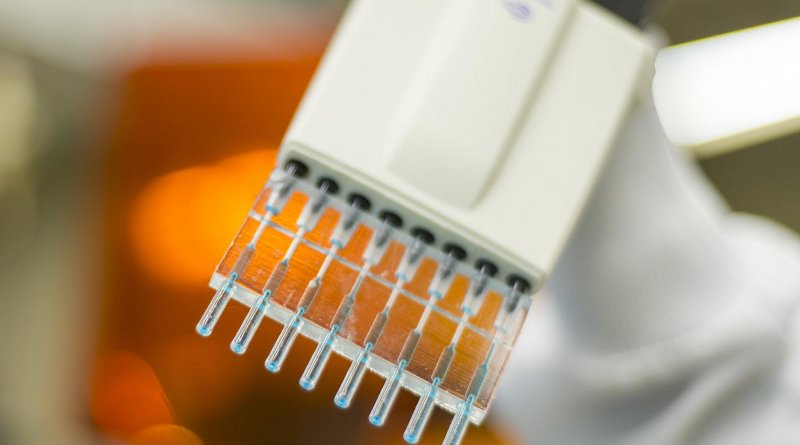New 3D-Printed Technology Lowers Cost Of Common Medical Test
A desire for a simpler, cheaper way to do common laboratory tests for medical diagnoses and to avoid “washing the dishes” led University of Connecticut researchers to develop a new technology that reduces cost and time.
Their pipette-based technology could also help make certain medical testing available in rural or remote areas where traditional methods might otherwise be prohibitively expensive and complicated to conduct.
The 3D-printed pipette-tip test developed by the researchers leverages what “has long been the gold standard for measuring proteins, pathogens, antibodies and other biomolecules in complex matrices,” they say. The method still employs the enzyme-linked immunosorbent assay, also known as ELISA, but through a different route. They detailed their findings in a paper recently published online in Analytical Chemistry.
For 30 years or more, ELISA has been used to test blood, cells and other biological samples for everything from certain cancers to HIV, from Lyme disease to pernicious anemia.
Traditional ELISA tests are performed on plates featuring 96 micro-wells; each well works as a separate testing chamber where samples can be combined with various agents that will then react with the sample, typically by changing color. Technicians can then analyze whether a sample contains indicators of a particular disease or condition depending on the intensity of the color produced during the reaction.
While effective and accurate, the equipment used to run ELISA is expensive – often costing thousands of dollars to install in a lab – and requires specialized training to conduct testing, as improper techniques can lead to incorrect results. The agents used in the actual tests – usually various forms of antibodies – can be expensive as well.
Like many research laboratories, James Rusling’s chemistry lab where research assistant Mohamed Sharafeldin and his primary collaborator, Karteek Kadimisetty ’18 Ph.D., conducted their work, doesn’t have an automated ELISA washing machine, meaning that plates being used for tests must be manually washed – a time consuming and difficult process.
“The ELISA washing techniques take forever,” said Sharafeldin, who is currently working toward his doctorate in chemistry. “It’s very tough, especially in a lab like ours. We don’t have those kind of fancy washing machines.”
When Kadimisetty was running ELISA one day, he mentioned, “I wish doing ELISA was as simple as pipetting.” That offhand comment was the impetus for what followed: a design for a 3D-printed adapter for commonly used pipettes that could run an ELISA test right in the pipette tip, without the need for a traditional ELISA plate and the expensive equipment that goes with it.
Each single-use pipette tip represents one micro-well on an ELISA plate; the researchers also designed a multi-tipped version that allows for eight tips to be pipetted at the same time. The tips fit snugly onto most pipettes used in laboratory settings, making fluid handling much easier than with the standard ELISA plate.
“We didn’t want to make a big change in the traditional ELISA; we just made engineered, controlled changes,” Sharafeldin said. “So, the basics are the same. We use the same antibodies at the same concentrations that they use with conventional or traditional ELISA, so we are using the same protocols. Anything that can be run by normal ELISA can be run by this, with the advantage of being less expensive, much faster and accessible.”
The researchers tested the pipette tips on samples from prostate cancer patients and found not only were the test results from the tips as accurate as ELISA tests, they were able to conduct the tests with one-tenth of the amount of testing agent – significantly reducing the overall cost of the test – and at a fraction of the time. Tests conducted by different users with different levels of skill ultimately demonstrated the same results.
Traditional ELISA plate micro-wells hold 400 microliters of fluids each, but the reactions needed to measure test results only occur on the plastic walls of the well. While the 3D-printed ELISA tips hold only 50 microliters, the design of the reservoir inside the tip dramatically increases the surface area where reactions occur, allowing the researchers to use much less of the costly antibodies used to conduct the test, and significantly reducing the time needed to process the test and read the results.
“Here we have a chamber where the reaction happens at all points,” Sharafeldin said, referring to the pipette tip design. “This reduces the time of the assay, which is an important thing, because the ELISA assay takes from five to eight hours to run. This one can be run in 90 minutes.”
The pipette tips also don’t require an expensive or sophisticated plate reader to determine test results, as ELISA tests do. In the trials with the prostate cancer samples, the pipette tip results were accurately read by taking a cell phone photo and using a free app that measures color intensities in the image.
The benefit, Sharafeldin said, is that the user conducting the test with the pipette tips doesn’t have to be a scientist; they just need simple pipetting instructions, then to take a photograph and send it to a technician who could remotely read the results to help make a diagnosis – potentially providing new, lower-cost testing options in rural or isolated areas where establishing a traditional ELISA lab would prove challenging and expensive.
While additional sample testing is needed, Sharafeldin is optimistic about the future potential for the pipette tip design to reduce costs. He is also engaging with engineers to design an automated, vacuum-assisted pipette that would further ease the use of the pipette tips and the conducting of ELISA tests, and would be available for significantly less cost than traditional ELISA equipment.

